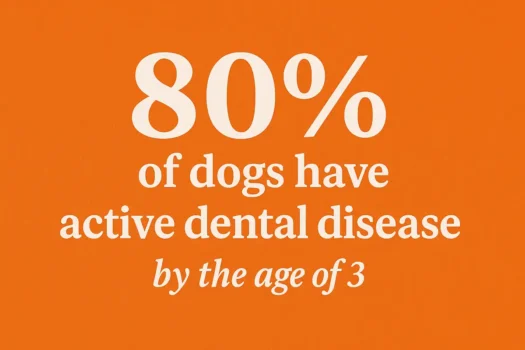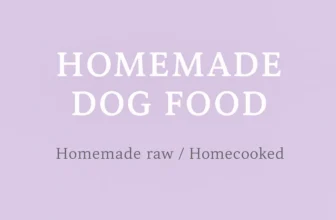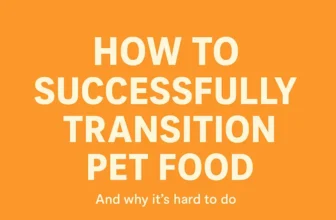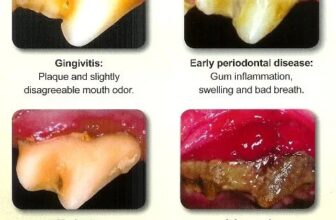Dental disease in dogs – The truth, and what we can do to prevent it

Would you call dental disease an epidemic if up to 80% of dogs (and cats) in Australia are suffering some form of the disease by the age of three?
Crazy, right?
According to VCA Animal Hospitals, “dental disease is one of the most common medical conditions seen by veterinarians.”
Is your dog one of them?
Your veterinarian may recommend a processed dry food as a solution, or some kelp supplement, but do you believe these are real solutions?
I don’t think they are.
It begs the question – How can so many Australian pets suffer from dental disease – a serious condition – at such a young age?
Let’s discuss the truth.
And by truth I don’t mean what the multi-billion dollar pet food industry tells us, or teaches our veterinarians.
I mean the simple facts – commercial pet foods cause dental disease.
The harsh truth
I have witnessed first hand the harm dental disease can cause our pets.
Rotting teeth and rotting jaws of cats and dogs barely in middle age, desperately needing their teeth extracting under anesthetic. It’s not good news.
As pet owners we often miss the early signs of dental disease (discussed below), and it’s also easy to miss (or misunderstand) the symptoms as the disease worsens and starts to affect the overall health of our pets.
Dental disease leads to organ disease, and as pet owners we should always be mindful, and we should be in the habit of checking our dog’s teeth regularl.
It’s far better to take precautions now, rather than suffer the consequences later.
What is the biggest cause of dental disease in our pets?
You may think it’s bad luck, but it definitely isn’t.
You may think your breed is more prone to dental disease than other breeds (there’s a section on this later), but given science suggests 80% of dogs can suffer dental disease from a young age, breed can’t be the most likely reason, can it?
Pet food is the biggest cause of dental disease, and this is the real epidemic.
It’s not just bad food either, it’s good food as well.
A bad diet is obviously much worse, but dental disease in dogs and cats is an issue with food types and lack of mechanical cleaning – or shall we say chewing and gnawing.
Soft wet mush, processed nuggets of grains and/or vegetable matter, even fancy expensive foods like BARF, slow-cooked, gently dried, freeze dried, or raw diets of mince and organs – none of these diets will stop your dog developing dental disease, because your dog puts zero effort into chewing them.
When you understand that, it comes as no surprise up to 80% of Australian cats and dogs suffer from this terrible disease which leads to so much discomfort and ill health.
We fail to give our domestic pets what they instinctively use to keep their teeth clean, then wonder why they’re sick.
If zookeepers fed kibble made of starchy carbs to lions and tigers, we’d likely have 80% of them suffering dental disease in no time (and the remaining 20% escaping to find a proper meal).
How can we prevent dental disease in our pets?
The answers are simple, folks!
And you’ve probably guessed it already?
Ignore the marketing powers of big pet food companies – they want to sell you products for whatever illness your pet may encounter, because that’s how business works. Dental “kibble” made of starchy carbs – pah! Dental treats made of wheat and glycerin with a sprinkling of peppermint – yeah, right! Some magical kelp powder you sprinkle over your dog’s head like fairy dust….?
Let’s go back to basis – What rots your own teeth?
We know this already – bad food, lack of brushing.
What do we class as bad food?
Starchy food, sugary food, processed food.
What do you think dry pet food is?
All of the above!
Most of the time this is all we feed our pets, and guess what – we assume that will offer them great health for many years to come. But it doesn’t. Even if you’re spending a fortune on fancy whole prey patties or raw meal with ground bone… do you think ground bone offers mechanical cleaning?
Do you brush your dog’s teeth?
I bet you don’t, and I bet you don’t pay your vet to undertake dental cleaning under anesthesia either (not that we want to unnecessarily put our pets at risk of anesthetics).
Your dog or cat can clean their own teeth if you provide them a very simple tool to clean them with – something to chew.
Forget about brushing (my cat is 15 with impeccable teeth and they haven’t been brushed once in his whole life!)
Do you want to know what they can chew to prevent dental disease?
Opt for one or more of the following:
- Raw meaty bones – Nature’s perfect dental cleanser, which is why cats and dogs intuitively chew. Great for chewing, great for health.
- Tough meat-based chews – If raw isn’t your thing or you’re concerned about bones, then tough meat chews are a great option. Great for chewing, great for health. You’ll find some suggestions on the recommended treat page.
- Marrow-filled bones – Great for chewing, great for health (I’m repeating myself, aren’t I!?)
- Tough chew toys – Keeping in mind we are getting less effective as we go down this list, but tough chew toys (Kong is a great example) will help clean your dog’s teeth (not very effective with cats though!)
- Natural treats – Carrots, apple slices.
- Fancy new-age dentals gimmicks (herbs/seeds/algae) – I’ll say gimmicks because the solutions at the top of this list will be far more effective than what you may be recommended on a holistic pet feeding group on Facebook, but science somewhat suggests the following may (or may not) improve your dog’s dental health – peppermint oil (antibacterial, freshens breath), parsley (vitamins, freshens breath), pumpkin seeds (zinc, antioxidants, tartar support), flax seeds (omega 3, anti-inflammatory), kelp (supports oral microbiome, minerals).
The 4 grades of dental disease
Below are the different stages (or grades) of dental disease.
Did you know Grade 4 is when most pet owners seek the assistance of a veterinarian?
How many times have you heard someone pass off “dog breath” as if ‘s normal?
| Grade | What it looks like | Symptoms | How to tackle it |
|---|---|---|---|
| 1 – Early / mild | A little tartar on the teeth, gums slightly red | Hardly noticeable; maybe a hint of bad breath | Focus on a diet with raw meaty bones or tough meaty chews to naturally scrape teeth. Brushing can help but is secondary. |
| 2 – Moderate | Tartar is obvious, gums red and swollen | Bad breath, some discomfort, gums starting to recede | Switch to a diet that includes harder, chewing-friendly foods. Consider a professional dental cleaning to remove built-up tartar. |
| 3 – Advanced | Heavy tartar, gums receding, some teeth may be loose | Pain, trouble eating, bleeding gums, strong bad breath | Diet alone may not be enough; use raw meaty bones or tough chews to support oral health, and see your vet for cleaning or extractions. |
| 4 – Severe / periodontal disease | Severe infection, bone loss, multiple loose or missing teeth | Severe pain, drooling, weight loss, risk of infection in other organs | Urgent veterinary intervention required. Support recovery with a diet of raw meaty bones or tough chews; brushing is helpful but secondary. |
* Soft diets – even high quality BARF or dried foods – won’t clean teeth any better than a dry pet food.
* Raw meaty bones / tough meat chews provide mechanical cleaning and gum massage.
* Diet is the foundation of good dental health.
It’s never too late to change your dog’s diet!
REMOVE ROTTEN TEETH!
If your dog has rotten teeth, have them removed.
It may sound cruel, but it’s not – it’s the best solution for the health of your dog.
Dogs (and cats) can cope surprisingly well with teeth removed. Did you know they can crunch bone with toothless jaws? Even without teeth they can adapt to gnaw, chew, and consume a better diet, although usually with a tongue which flops out the side of their mouth.
If you leave rotten teeth in your dog’s mouth, you’re forcing them to fight bad bacteria, and that’s not what you want.
Have the teeth removed, improve their diet (using the advice above), and you will offer them your dog a better and healthier future.
Dog breeds more prone to dental disease
All dogs are prone to dental disease, but you figured that out already given up to 80% of the Australian dog population suffers from some stage of the disease from only three years old.
Small and toy breeds are more effected, for reasons we will cover below – but also because wet mush in a can is more affordable for small mouths and tends to be considered “better”.
If you have one of the breeds mentioned below they will be more at risk, although we should really say more at risk from their diet
| Breed category | Specific breeds | Why they’re prone to dental disease |
|---|---|---|
| Toy and small breeds | Chihuahuas, Dachshunds, Yorkies, Shih Tzus | Small mouths mean crowded teeth, which makes them harder to clean and lets plaque build up. |
| Brachycephalic breeds | Pugs, Bulldogs, Boxers | Short muzzles cause misaligned teeth that trap food and bacteria. |
| Other breeds | Dachshunds, Collies | Certain dental anatomy puts them at higher risk of plaque and tartar. |
Questions?
If you have any questions, thoughts, or opinions – please add a comment below.
What advice can you give to help others? What suggestions can you make help our pets avoid the consequences of dental disease?

Join the Reddit community r/HealthyAussiePets







Agree With everything you’ve supplied here David, well done!
I’ve fed RMB’s for the past 15 yrs to 3 dogs and a litter.
There are some challenges that pet parents have, me included. When I lived closer to Perth, never had a problem sourcing RMB’s, but when I had to move to a more regional area its been very challenging sourcing appropriate bones, so I’ve had to apply other options.
I also have a dehydrator which has been great for making dental chews for my small dogs, not appropriate for my golden retriever, but she still had them as a treat.
Since I moved I haven’t been able to source body parts to dehydrate, so I’ve had to resort to buying them already dehydrated online.
I do include other support for their teeth and gums, not just RMB’s and a fresh raw diet!
IMO, dogs need large pieces of meat to chew, plus bones and other options. People with large dogs, unless they feed whole prey or body parts, this is challenging for them.
I don’t brush, but I do apply other options to the gums/teeth and mouth.
My youngest who was weaned onto raw, his teeth have been excellent. He turned 10 this year and the only vet intervention he’s needed was last year, one of his pre-molars fell out. I wanted to make sure there wasn’t anything left behind, so I had an xray done, and at the same time I ordered a dental clean. I figured, why not, that way hI can start again from a clean slate.
The Xray was all good, but as I suspected he had some tartar on the inside of his molars, the most challenging area, UNLESS the appropriate bones can be sourced.
What I’m trying to say is.. if anyone has a challenge sourcing suitable bones, just know there are other options you can apply as a layered effect.. which DO work, I know this from my own experience. The hard dehydrated chews work great for small/med dogs.
About 8 yrs ago I published a comprehensive post in A Nature Intended, but FB went and removed it 5 yrs later! So I’ve had to find other means to get this information out there. I will endeavour.
Keep up the great work David
Hi Karen,
I’m always grateful for information such as this, and always feel free to add links to any articles you may have (which haven’t sadly been removed from Facebook!)
I suppose in rural areas you’re more limited to stockfeed and pet stores selling cheap feed? I wonder if there are any solutions to making raw meats/bones more readily available in rural areas? I expect the issue is more logistics rather than competition from budget pet food brands.
I agree with this, My dogs have perfect teeth at 7 years of age and without fail I give them a lamb shank each at least one per week. Its their favorite treat and costs me $10-$15 for them both, I think $600 a year extra to keep their teeth pristine is well worth the investment, they of course get other good quality food as well.Nothing beats a geuine bone, nearly everything else is processed.
Job well done!
Hi… when you say lamb shank do you mean dried like ZiwiPeak or fresh ? Would love more info. Thanks.
Hi Sam,
There’s benefits for both. The ZIWI shanks are tough and long lasting, whereas raw lamb shanks also do a great job of cleaning teeth as well as being a healthy satisfying meal.
Caveats – raw shanks tend to be better for medium/large breeds, must be raw (never cooked), and if your dog isn’t used to raw bones then keep tabs until they’re used to it.
Bugsy has bully sticks available online by the kilo, which come at a fraction of the eye popping cost we see them at retail stores.
They’ve also recently upgraded their shark cartilage chews into a longer lasting stick form which are excellent teeth cleaners.
Witht he bully sticks Joe, are you worried about the end piece being swallowed whole and do you use one of those gadgets to stop that ? We got one bag and then freaked out about that issue sadly.
It depends on the chewing habits of your dog. Does your dog tend to gulp things?